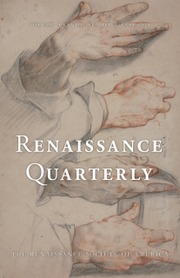This innovative, provocative collection of articles reflects on Miguel de Cervantes’s sometimes successful use of theatricality to create performative spaces both on the historical stage of the corrales (the improvised circle in the street for the performers) and on the pages of his comedias, interludes, and, surprisingly, prose. Inspired by the theoretical concept of “the empty space” from Peter Brook’s 1995 iconoclastic publication, the editors evaluate the magical creativity of an individual that plays an acting role, makes a facial or body gesture, or adopts a persona under the close observance of a viewer.
Divided into two sets of contributions, part 1 examines alternate theatricalities in Cervantes’s drama. Bruce Burningham’s article identifies the Cervantine emphasis on the fictive and the physical spaces in his teatro, some problems with the stage directions and the number of actors and artifacts involved, and the lack of a jongleuresque tradition in his creations as possible explanations for why the auther of Don Quixote failed to succeed as a playwright. In their two writings on El rufián dichoso, a hagiographic play with a small dose of saintliness, John Slater and Sonia Velázquez analyze the portrayal of confusing identities through cross-dressing, gender-bending, geographical vagueness, narrative fluidity, wagers, and gambling. Julia Domínguez, Sherry Velasco, and Ana Laguna concentrate their three pieces of research on captivity (which was personally experienced by Cervantes) to conclude that in El trato de Argel, Los baños de Argel, and La gran sultana, mnemonic exercises of past events, emotional remembrance of sad musical melodies, and the portrayal of a harem as a locus of desire could be used in order to re-create old traumatic incidents related to race, faith, and gender. Esther Fernández and Adrienne Martín close this first subdivision of the volume with a serious contribution in which they describe the spatiality of four different scenarios in Cervantes’s entremeses —namely, the domestic, the urban street, the supernatural, and the invisible backstage—to demonstrate the author’s engagement with the social reality of his theater, his production of moral lessons that extend beyond individual behavior, and his construction of scenarios filled with meanings that are not normally associated with other elements of drama.
Part 2 of this collection of essays includes six more articles that outline acts of disclosure and revealing in Cervantes’s prose. B. W. Ife investigates the theatricality of several critical moments in four novelas ejemplares—namely, La gitanilla, La española inglesa, La fuerza de la sangre, and La ilustre fregona—in which a crime or injustice is committed against an innocent woman who is rescued and rewarded at the end due to her fortitude and integrity. Catherine Infante revisits the mise-en-scène of the theme of captivity in the presentation of Maese Pedro, the account of Ruy Pérez de Viedma in Don Quixote, and the episode of the false captives in Persiles y Sigismunda to assess the response of the fictional spectators to the reenactment of these stories. Mercedes Alcalá Galán also analyzes this reaction in the tableau vivant of Camila’s sham suicide in El curioso impertinente, a dramatized pictorial performance of The Suicide of Lucretia. As for passionate relationships, Paul Michael Johnson studies the theatrical representation of love in La Galatea through the use of gestures. Eduardo Olid Guerrero scrutinizes this artifice in relation to examples of espionage and eavesdropping deployed at home and abroad by several characters in Don Quixote that remind us of secret intrigues at court. The last article of the collection, written by José Cartagena Calderón, delves into the representation of aging masculinities, including that of Cervantes, in relation to medical treatises of early modern Spain that proclaim anxieties about marital impotence and fear of cuckoldry.
The wide range of contributions makes this volume unique. Drawing the Curtain is one of the first studies that examine theatrical techniques beyond the limited room created within the three walls and curtain of the traditional theater. The essays discuss the alcalaíno author’s technique to reveal hidden identities and truths in order to request the attention of the curious reader, interact with the audience of the spectacle, and surprise the spectator at the performance.



